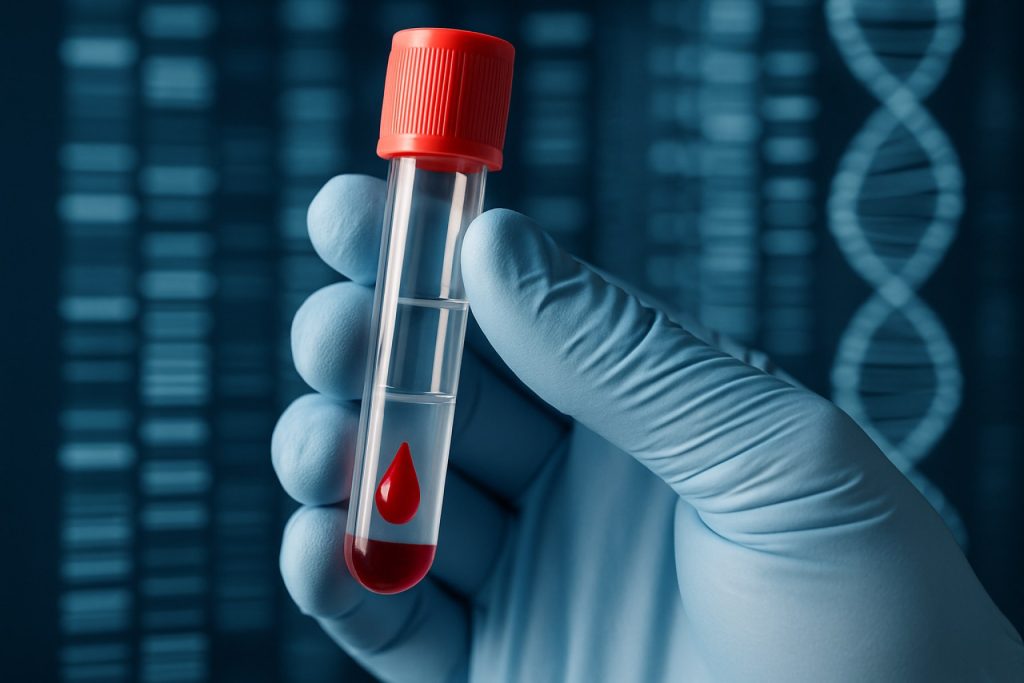
- Epigenetic biomarkers, especially DNA methylation patterns, offer major improvements for early cancer detection over traditional genetic mutation analysis.
- Liquid biopsies using tiny blood samples can now reveal both genetic and methylation information, enhancing diagnostic accuracy even with minimal circulating tumor DNA (ctDNA).
- Innovative techniques preserve methylation signals during sample preparation, allowing efficient and non-invasive cancer screening and monitoring with just one test.
- Targeting repetitive DNA regions and specific methylation markers enables precise detection and localization of cancer, improving personalized treatment strategies.
- The merging of genomics and epigenetics is revolutionizing cancer care—soon, routine blood tests may diagnose cancer early and guide individualized therapies.
Imagine a world where diagnosing cancer is as simple as drawing blood at your annual checkup—a world where early-stage tumors can’t hide, and a tiny vial reveals not only if cancer is present, but where it lurks within the body. That vision edges closer to reality as scientists harness the language written in our DNA, not just its sequence, but its symphony of chemical modifications—the world of epigenetics.
Beyond Genetics: The Methylation Revolution
While doctors have relied for years on genetic mutations to spot cancerous cells, these clues often vanish in the fog of early disease. The small fragments of DNA—circulating tumor DNA, or ctDNA—that shed from hidden tumors remain elusive, sometimes only whispers among billions of healthy strands. Standard blood-based “liquid biopsies” aim to catch these fleeting signals, but they stumble at cancer’s earliest, most curable moments.
Recent innovation lies in examining DNA methylation—chemical tags that decorate DNA and orchestrate the turning on and off of genes. Such patterns shift dramatically in cancer cells. Unlike single genetic mutations, methylation markers are prolific, increasing the odds of catching their presence even when ctDNA is scarce. As a result, researchers are lighting up new pathways to earlier, more precise diagnoses.
Tiny Samples, Giant Leaps
The technical challenge looms large: a tube of a patient’s blood yields barely ten nanograms of DNA, a vanishingly small amount. To extract the most information, researchers face a dilemma: splitting the sample for genetic and epigenetic analysis risks losing critical data. Traditional methods can even erase methylation signatures during preparation, rendering them invisible.
Innovative laboratory solutions, like novel target enrichment systems, now leave methyl groups untouched during sample prep. Scientists can retrieve both genetic mutations and methylation signals from a single, precious sample, essentially doubling their insight without asking more of the patient. This “do more with less” approach opens new frontiers for monitoring disease progression and tracking whether a tumor responds—or resists—treatment.
From Repetitive Patterns to Real-Time Answers
Cancer’s DNA isn’t just mutated—it’s littered with repetitive regions and “jumping genes” called retrotransposons. Some of the most promising methylation markers cluster around these sites, but standard DNA-capture tools avoid them, fearing false signals. Researchers, however, are exploring how to reliably sequence these tricky regions, envisioning simple, fast clinical tests that might one day run routinely in hospital labs worldwide.
These technologies don’t just promise to spot cancer earlier—they could pinpoint its source. Because methylation is a molecular address stamp, showing where DNA originated in the body, a single test could soon guide doctors instantly to the tissue of origin, refining treatment for each unique patient.
What This Means for You
The fusion of genomics and epigenetics signals a seismic shift in cancer medicine. Tools once confined to high-tech research labs are rapidly evolving toward everyday clinical use, where physicians can diagnose, monitor, and personalize cancer care from just a small blood sample. This non-invasive approach could transform early detection, turning cancer from a silent threat to a foe caught before symptoms ever surface.
The key takeaway: The next revolution in cancer detection won’t just search for missing puzzle pieces—it will read the chemical handwriting written on each DNA strand. As this science moves from lab bench to bedside, every drop of blood may soon tell a clearer, life-saving story.
For trusted updates on the future of medical technology, visit World Health Organization or learn more about breakthroughs in research at Cancer.gov.
Revolutionary Blood Tests: How DNA Methylation Is Set to Outsmart Cancer Even Before It Starts
The Future of Cancer Detection: Unveiling the Secrets of DNA Methylation
What Is DNA Methylation and Why Does It Matter?
DNA methylation involves tiny chemical tags (methyl groups) that attach to DNA, regulating which genes are switched on or off. Unlike genetic mutations, which change the actual code, methylation changes affect gene expression—critical in cancer, where normal controls often break down. Cancer cells display unique methylation signatures that begin to shift long before symptoms arise or tumors become visible on scans.
Additional Facts Not Fully Explored
– Multi-Cancer Early Detection (MCED): Companies are developing “multi-cancer” tests using methylation markers to screen for multiple cancers from one blood draw. Examples include GRAIL’s Galleri and Thrive’s CancerSEEK, which analyze methylation and other biomarkers to detect more than 50 cancer types (source: Cancer.gov).
– Tissue of Origin Identification: Methylation patterns serve as a molecular “address label,” letting doctors identify not just the presence of cancer but its tissue of origin even when imaging fails to locate a tumor.
– Sensitivity at Early Stages: Epigenetic-based blood tests can sometimes detect stage I cancers, which are vastly more treatable than later-stage diagnoses. A study in Nature (2020) reported methylation assays correctly flagged early cancers in over 65% of cases—much higher than standard ctDNA mutation-based tests.
– Minimal Invasiveness: These blood-based assays (liquid biopsies) only require a blood sample, eliminating the need for invasive tissue biopsies with risks and delays.
– Broad Application: Beyond cancer, abnormal methylation is implicated in neurological disorders (Alzheimer’s), autoimmune disease, and aging—suggesting future tests could offer even more comprehensive health monitoring.
How-To Steps: How Could My Doctor Use This Test?
1. Blood Draw: A small vial of blood is taken during a regular visit.
2. Sample Processing: Laboratory separates DNA fragments, preserving both genetic mutations and methylation markers.
3. Sequencing Analysis: Machines read epigenetic patterns—looking for known cancer-associated methylation changes.
4. Interpretation: Algorithms compare your DNA’s chemical marks to vast cancer databases.
5. Results to Action: If suspicious methylation is found, doctors can direct targeted imaging or biopsies, or begin close monitoring ahead of symptoms.
Real World Use Cases
– High-Risk Surveillance: For people with genetic predispositions (like BRCA mutations), frequent methylation-based blood tests can add an extra layer of early detection.
– Hard-to-Biopsy Tumors: In lung, pancreatic, or brain cancers—where traditional biopsy is risky—methylation blood tests provide a safer diagnostic option.
– Monitoring Remission: After cancer treatment, these tests can catch minimal residual disease or recurrence months before conventional scans.
Market Forecasts & Industry Trends
– Exponential Growth: Liquid biopsy market size is projected to reach $9.3 billion by 2028, driven by epigenetic innovation.
– FDA Interest: The US FDA is evaluating multiple MCED test submissions, which could pave the way for routine cancer screening.
– AI-Driven Algorithms: Machine learning is enhancing sensitivity and reducing false positives, rapidly improving the accuracy of methylation profiles.
Reviews & Comparisons
– Methylation vs. Mutation Testing: Methylation-based assays outperform mutation-based ctDNA tests at early detection, since methylation signals are more abundant and diverse.
– Commercial Solutions: Galleri, CancerSEEK, and others show promise but vary in cancer types detected, cost, and insurance coverage.
Controversies & Limitations
– False Positives: Non-cancer conditions (like inflammation) can alter methylation, sometimes leading to unnecessary additional tests.
– Cost & Accessibility: Current tests may cost upwards of $900–$1500 per screen and are not yet widely covered by public healthcare.
– Need for Confirmatory Diagnosis: A positive blood test must still be followed by imaging or biopsy, since no screening tool is infallible.
Features, Specs & Pricing
| Feature | Methylation Blood Test | Mutation-Based ctDNA |
|—————–|—————————-|———————————–|
| Sensitivity | High (esp. early stage) | Moderate (early detection tough) |
| Tissue of Origin| Usually identifiable | Often indeterminate |
| Turnaround Time | 1–2 weeks | 1–2 weeks |
| Cost (est.) | $900–$1500 | $800–$1500 |
Security & Sustainability
– Privacy: DNA data is highly sensitive; labs must comply with regulations like HIPAA and GDPR.
– Sustainability: Less reliance on invasive biopsies reduces medical waste and lowers patient risk.
Insights & Predictions
– Integration With Wearables: Future models may combine blood-based methylation tests with AI-driven health trackers for dynamic real-time risk analysis.
– Broader Screening: As costs fall, annual methylation screening for middle-aged adults could become as routine as cholesterol checks (source: World Health Organization).
– Therapeutic Targeting: Methylation analysis may also reveal which therapies will be most effective for each tumor, advancing personalized medicine.
Most Pressing Questions Answered
– How Accurate Are These Tests? They can detect multiple cancer types with sensitivity between 39–93% and specificity >95%, depending on cancer and stage.
– Will Insurance Cover It? Coverage is variable, but as tests gain FDA approval and guideline inclusion, broader coverage is expected.
– Can It Replace Mammograms, Colonoscopies, etc.? Not yet—it’s a complementary tool, best used alongside established screening, especially for hard-to-detect cancers.
– When Will They Be Available for Everyone? Multiple tests are now available in select clinics; widespread rollout is expected within 3–5 years.
Pros & Cons Overview
Pros:
– Non-invasive, minimal risk
– Detect multiple cancer types from one test
– Possible identification of tissue of origin
– Suited for monitoring post-treatment recurrence
Cons:
– False positives/negatives possible
– Expensive and not always covered
– Requires sophisticated lab analysis
– Cannot entirely replace existing screening for all cancers
Actionable Recommendations & Quick Tips
– Stay Informed: Subscribe to updates from trusted sources like Cancer.gov and World Health Organization.
– Ask Your Doctor: If you’re in a high-risk group, discuss trial or early-access methylation-based tests as a supplement to regular screening.
– Update Your Family History: Personalized DNA testing works best with comprehensive family and health records—keep them up to date.
– Privacy First: Use accredited labs and review privacy policies when sharing any genetic or epigenetic data.
CONCLUSION
Epigenetic blood tests are revolutionizing the fight against cancer, offering earlier, more precise, and less invasive detection than ever before. As technology matures and costs drop, discussing this breakthrough with your healthcare provider could one day become a life-saving habit. Stay proactive, stay informed, and be ready for the future of preventative cancer care.



